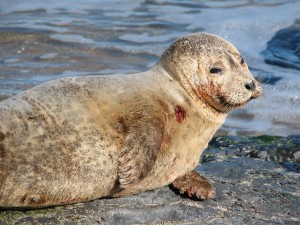Marine Mammal & Sea Turtle Week (Part 5 of a 5-part Series)
With Memorial Day Weekend upon us, summer is unofficially here for New Jerseyans. That means plenty of tourists enjoying shore, sand, surf, and sun – but it also means other types of annual summer visitors to our coast: bottlenose dolphins, sea turtles, and whales. However, what may be inspiring sightings from a healthy distance can become tragic encounters when marine animals become stranded or entangled in nets.
This story marks the fifth of five blog stories spotlighting New Jersey’s marine mammals and sea turtles – and educating people how to help animals in need, rather than make a bad situation worse.
Part 1, Monday, revealed the bottlenose dolphin die-off striking the Eastern Seaboard. Part 2, on Tuesday, featured a Question-and-Answer on the dolphin mortality event with NOAA’s Mendy Garron. Part 3, on Wednesday, looked at how people can safely help stranded wildlife. Part 4, yesterday, investigated the fascinating condition of cold-stunned sea turtles. Part 5, today’s blog entry, discusses the importance of reporting marine mammal and sea turtle sightings and how to do so.
MARINE MAMMAL & SEA TURTLE WEEK: Reporting Your Marine Mammal & Sea Turtle Sightings
By Michael J. Davenport, Marine Species & GIS Programs Manager
Conserve Wildlife Foundation (CWF) staff work with the New Jersey Endangered and Nongame Species Program (ENSP) to manage and populate the state’s official database of rare wildlife, known as Biotics. Currently, this database contains over 39,000 animal and plant records within New Jersey. ENSP and CWF currently collect and enter data for the state’s 182 endangered, threatened, and special concern species.
Although much of the information within Biotics on imperiled species is received from CWF and ENSP biologists, a great deal of useful data is also submitted by the public since, although NJ is a relatively small state, the biologists are unable to survey all areas at all times. The biologists rely on these “citizen scientists” to help them monitor areas which they are unable to and/or locate the presence of species in areas in which they were previously unknown to occur. Wildlife watchers who observe rare wildlife may report such observations by submitting a Rare Wildlife Sighting Report Form which then gets processed and mapped by CWF staff.
Rare species data within the Biotics database plays a critical role in wildlife and habitat conservation within New Jersey. It is used for a number of scientific and conservation efforts such as the state’s Landscape Project and Critical Wildlife Habitat Mapping, environmental review, research (GIS modeling), status review (determining whether a non-listed species should become listed as endangered or threatened and vice versa), and it also assists biologists in targeting future survey efforts to new areas.
A Rare Wildlife Sighting Report Form is available on ENSP’s website for download as well as instructions for completing the form – there is also a Marine Wildlife Sighting Report Form, specifically for reporting sighting of marine mammals and sea turtles. A complete list of all of the species tracked by the state can be downloaded here.
Reporting your rare wildlife observation is easy. Simply complete the form, attach a map of where the animal was observed (a map is not necessary for marine sightings; geographic coordinates may be submitted instead), as well as any photographs taken, and then mail or e-mail the form and any additional documentation to ENSP at the address provided on the form. For more details about the state’s rare species mapping, please visit our webpage.

Observations of dead, dying, or stranded marine mammals or sea turtles should be reported to the Marine Mammal Stranding Center at 609-266-0538. Keep in mind, however, that a seal on the beach is not necessarily sick or injured. Resting on the beach is normal behavior for seals. They may haul-out onto beaches, jetties, or floating docks to rest or escape predators. So, a seal on land is not necessarily a seal in distress. Obvious indications of illness or injury are open wounds, entangled fishing line, or lack of responsiveness to their surroundings.
Discover more from Conserve Wildlife Foundation of NJ
Subscribe to get the latest posts sent to your email.